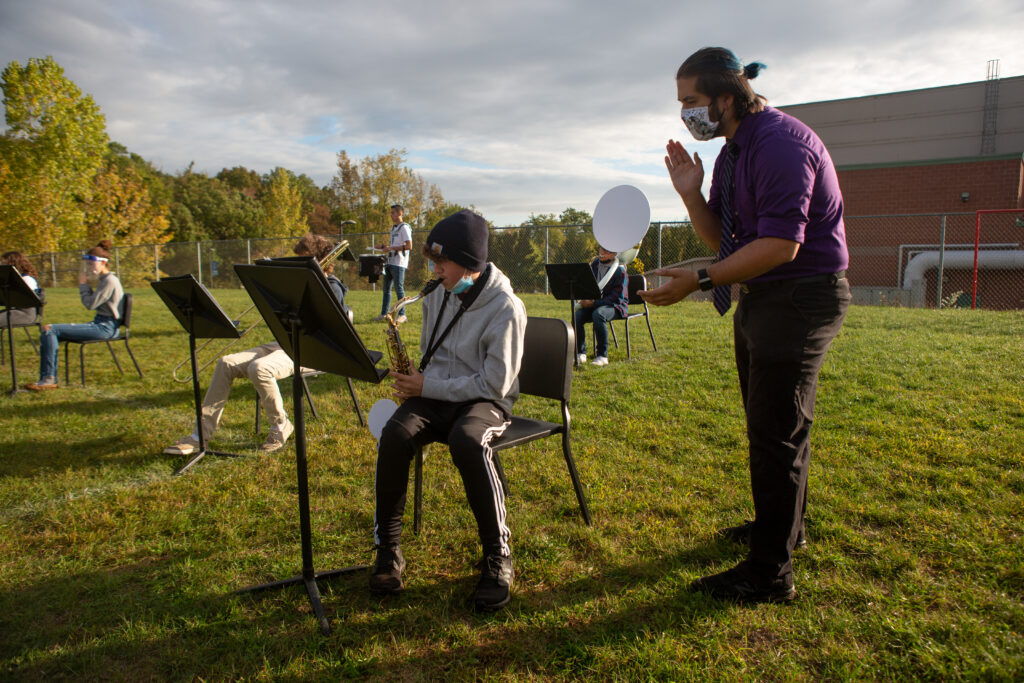Importance of Music and Art Education in Underprivileged Youth Oakland
 Credit: Allison Shelley for American Educational activity
Credit: Allison Shelley for American Educational activity
 Credit: Allison Shelley for American Didactics
Credit: Allison Shelley for American Didactics
For decades, arts and music teaching in California has been dying a slow death in many schools, strangled past upkeep cuts amid an ongoing accent on cadre subjects like reading and math and test scores as the measure out of student success.
Just now, as educators search for new strategies to excite students about learning, peculiarly during this grim pandemic, there is promise for their revival.
In contrast to several proposed ballot measures that would weaken public schools, former Los Angeles Unified Superintendent Austin Beutner is leading an effort to restore arts and music education to a more prominent place in the school curriculum.
With the backing of a growing number of artists and educators, Beutner wants to put an initiative on adjacent Nov'southward election that would require the state to spend between $800 million and $1 billion extra each year out of its full general fund for arts and music education in the state.
That'due south iv times more than the total budget of the National Endowment for the Arts.
A huge windfall for the schools?
Hardly. It's simply the equivalent of about one% of what the state currently on its schools required by Proposition 98, the initiative that dictates how much the state must spend on schools.
This week, the cause of arts and music teaching got a heave when Gov. Gavin Newsom included $ane billion for that purpose in his Expanded Learning Opportunities Program for the coming schoolhouse year.
As welcome as that funding would be, it is 1-time funding, and then there is no assurance the programs would continue. Nor would they be integrated into the curriculum, merely rather would be part of after-schoolhouse or summertime programs for One thousand-six students, and not accessible to all children.
That'due south why the initiative Beutner is promoting will still exist needed. In fact, it would just assist schools follow the spirit, if non the alphabetic character, of what they are already required to do by police force.
Information technology volition come equally a surprise to many Californians — as it did to me — that state law actually requires schools to provide, from first through sixth grade, "instruction in the subjects of trip the light fantastic toe, music, theater, and visual arts, aimed at the development of aesthetic appreciation and the skills of creative expression."
As for centre and high schools, the constabulary is even more prescriptive, saying schools "shall offering courses" in those subjects.
But these laws are weak in the farthermost: They don't specify how much instruction or how many courses should be offered, or by whom.
"Information technology mandates it, but there are no teeth to it," said Li Ezzell, an elementary school fine art teacher in the San Juan Unified School District near Sacramento who just stepped downwardly as president of the California Art Pedagogy Association.
The saving grace is that the University of California and the California Country University both crave that students take the equivalent of a yearlong course in the visual and performing arts for admission.
That's amend than aught, merely information technology'south totally inadequate, says Ezzell. "How can you peradventure say students have achieved some level of competency (in the arts) when they should take had 12 or 13 years in it, as they do in language arts, mathematics and to some degree in scientific discipline and social studies?"
So what we have now in California is tremendous variation in how much arts and music instruction is offered, as this map of arts programs in California powerfully demonstrates.
Berkeley Unified, where my children went to schoolhouse, has a vibrant music program offered to thousands of its students beginning in the third grade. It's merely possible considering of a parcel revenue enhancement on real estate approved by the required two-thirds vote of Berkeley voters.
Simply a fraction of districts are able to enhance that kind of money, and very few in poorer communities. As a result, schools serving low-income students, especially students of color, are less probable to have robust arts programs, notes Pedro Noguera, dean of the University of Southern California's Rossier School of Education.
Beutner's initiative, he said, would represent "an important footstep in addressing the issue."
The disparities are far too large. National data from a decade ago showed that white students were twice as probable equally Black and Latino students to take received an arts teaching.
The situation is worse now because many budget cuts made during the Great Recession have not been restored fully, if at all, farther eviscerating many programs.
Listen to the travails of Eloy Adame, a trumpeter, arranger and longtime music teacher who is starting an instrumental music programme from scratch at the Elizabeth Learning Heart, a Los Angeles Unified school with ane,500 nearly entirely depression-income Latino students. Nearly all the students qualify for free or reduced-priced meals. A large challenge is that the school only has 45 instruments for the 200 students in the program. Some instruments are in need of repair.
Earlier the pandemic, students would get their own mouthpieces and then share trumpets, for example, or get their own reeds and share clarinets. The pandemic has ended that practice. Adame says he needs as much as $90,000 just for instruments — and getting that kind of money out of school administrators is "inconceivable."
"They're more likely to say, 'Tin yous make it with piece of work with 10% of that?'"
This is non only a California trouble only as well a national ane. This fall, a commission appointed by the American Academy of Arts and Sciences issued a "telephone call to action" in its report titled "Art'due south for Life'due south Sake: The Example for Arts Didactics."
"Arts pedagogy was already in a state of crunch and dire need earlier the fraught yr of 2020, and the pandemic has intensified that crisis exponentially," the written report asserted.
John Lithgow, a multiple award-winning actor who lives in Los Angeles, is a co-chair of the commission and is backing the California initiative.
"I can but talk from my ain personal experience, just I'm certain it's true. It but enlivens the entire feel of education," Lithgow said, referring to the arts classes he took equally a student. "It made me want to go to school, and information technology helped me figure out who I was."
That echoes why rap artist and producer Dr. Dre is too on lath.
"I'g all in on giving kids more access to music and arts education because creativity saved my life," he said. "I want to practice that for every kid in California."
•••
Louis Freedberg is a past executive managing director of EdSource and a veteran education journalist.
The opinions expressed in this commentary represent those of the writer. EdSource welcomes commentaries representing various points of view. If y'all would like to submit a commentary, please review our guidelines and contact us.
To go more than reports like this one, click hither to sign up for EdSource's no-toll daily electronic mail on latest developments in education.
Source: https://edsource.org/2022/addressing-the-crisis-in-arts-and-music-education-in-california/664798

0 Response to "Importance of Music and Art Education in Underprivileged Youth Oakland"
Post a Comment